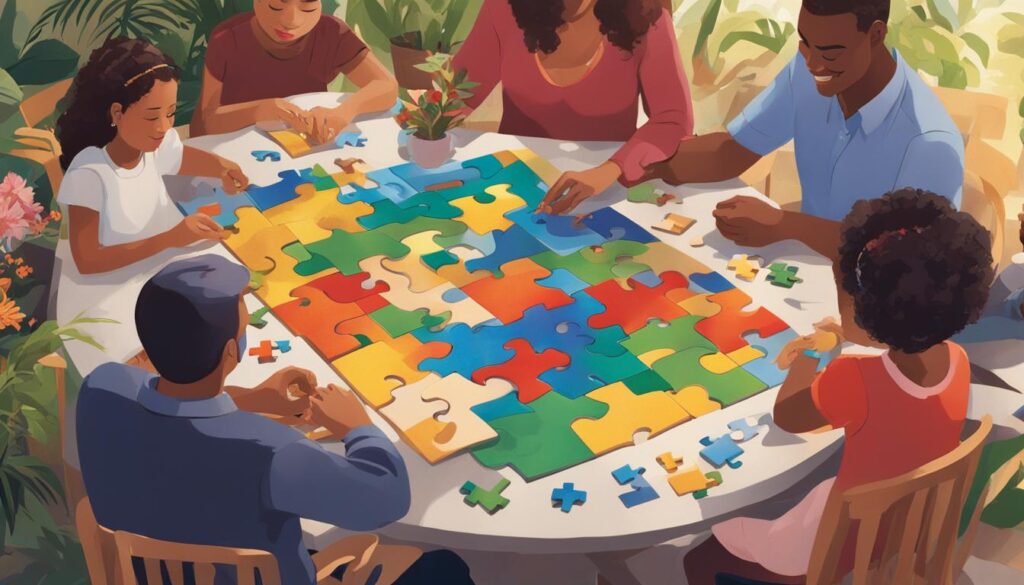Family dynamics can be challenging to navigate as our loved ones can often push our buttons and test our patience. However, learning to cultivate healthy relationships within the family unit is essential for overall fulfillment and well-being. In this article, we explore the intricacies of family dynamics and provide practical tips on how to build effective communication, resolve conflict, and nurture growth and development in your family.
Key Takeaways
- Healthy family relationships are vital for overall well-being and fulfillment.
- Effective communication and conflict resolution are essential for maintaining balance and harmony.
- Nurturing individual growth and development encourages self-discovery and personal fulfillment.
- Embracing diversity and managing differences within the family unit promotes a supportive and inclusive environment.
- It’s important to balance family responsibilities with quality time and self-care.
Understanding the Importance of Family Relationships
Family relationships are the foundation upon which we build our lives. Strong and healthy relationships foster, security, love, and a sense of belonging that boosts our mental and emotional wellbeing. Family relationships are more than just blood ties; they encompass a range of people who share a bond built on trust and respect.
According to a study by Harvard University, family relationships can have a significant effect on children’s development and future success. Children with strong family relationships are more likely to have better communication and social skills, higher academic achievement, and more robust emotional intelligence.
«Family relationships are the most important things in life because they provide us with love, support, and a sense of belonging.»
Having a united family means having a support system to deal with life’s challenges. It helps us navigate through difficult times and provides a sense of comfort and solace when we need it the most. This is especially true in times of crisis, making family relationships, an essential pillar for personal growth and resilience.
The Benefits of Strong Family Relationships
Strong family relationships come with various benefits that improve our emotional and mental wellbeing:
| Benefits | How it helps |
|---|---|
| Increased happiness | Support from family members can help us overcome the challenges of life, boosting our overall happiness. |
| Lower stress levels | Family members can serve as a source of comfort during stressful times, reducing our stress levels. |
| Improved physical health | Strong family relationships have been linked to lower rates of chronic illnesses such as heart disease and diabetes. |
| Better mental health | Family members provide emotional support that helps us cope with mental health issues such as anxiety and depression. |
| Improved communication | Strong family relationships encourage open and honest communication, leading to better problem-solving skills. |
Understanding the significance of family relationships is crucial in building and maintaining them. As cliché as it may sound, love and respect are the building blocks of strong family relationships. Regular communication, taking time to appreciate each other, and setting boundaries that respect individual space and choices go a long way in improving and maintaining strong family relationships.

Building Effective Communication within Your Family
Communication is the foundation of any healthy family dynamic, but it’s not always easy to get it right. Effective communication involves active listening, expressing oneself clearly and respectfully, and being open to different perspectives. By building better communication skills, you can resolve conflicts, strengthen relationships, and foster a more supportive and loving family environment. Here are some tips to help you get started:
Practice Active Listening
Active listening means paying full attention to the person speaking, without interrupting or getting distracted. Encourage family members to share their thoughts, feelings, and concerns, and make an effort to really hear them out. Ask follow-up questions to clarify their meaning and show that you’re genuinely interested in what they have to say.
Use «I» Statements
One common communication pitfall is using accusatory or judgmental language, which can make others feel defensive or attacked. Instead, use «I» statements to express your own feelings or experiences, without placing blame on others. For example, «I feel hurt when you cancel plans without letting me know in advance» is more effective than «You always bail on me.»
Practice Empathy
Empathy means putting yourself in another person’s shoes and understanding their perspective, even if you don’t necessarily agree with it. This can help you avoid misunderstandings and build deeper connections with family members. When someone shares their feelings or concerns, try to imagine how they might be feeling and respond with compassion and understanding.
Table: Common Communication Roadblocks

| Roadblock | Solution |
|---|---|
| Interrupting | Make a conscious effort to listen fully before responding |
| Criticizing | Use «I» statements to express how you feel, rather than blaming or attacking others |
| Getting Defensive | Try to stay open-minded and empathetic, even if you disagree with the other person |
| Ignoring Boundaries | Respect other people’s boundaries and ask for their consent before sharing information |
Improving communication is an ongoing process, but with practice and commitment, you can create a more harmonious, connected family dynamic. Remember that effective communication involves mutual respect, active listening, and a willingness to work together towards shared goals.
Resolving Conflict and Building Resilience
Healthy family relationships don’t mean that there are never any conflicts or disagreements. Instead, it’s how families handle these situations that make a significant impact on their long-term well-being and happiness.
One of the keys to resolving conflicts is through effective communication. When dealing with conflicts, make sure to maintain a respectful tone and actively listen to each other’s perspectives. It’s crucial to understand the root cause of the conflict to find a resolution that works for everyone. By acknowledging each other’s feelings and looking for common ground, families can prevent unnecessary arguments and promote harmonious relationships.
Avoiding conflicts is not a good strategy either. By ignoring conflicts and communication breakdowns, families may sweep issues under the rug, leading to resentment and unresolved issues bubbling over later. Instead, families can build resilience through overcoming conflicts together, growing through adversity, and coming out stronger on the other side.
Conflict Resolution Tips:
- Establish boundaries: Set clear expectations and boundaries for each family member to prevent misunderstandings and conflicts.
- Take responsibility for your actions: Owning up and apologizing for one’s actions can go a long way in resolving conflicts.
- Focus on the present: Avoid bringing up past conflicts that have already been resolved or forgiven.
- Brainstorm solutions together: Encourage each family member to share their thoughts and ideas towards solving the conflict and work towards finding a mutually agreeable solution.

By working together, families can overcome conflicts, build resilience, and create a stronger sense of togetherness.
Cultivating a Healthy and Supportive Family Environment
A healthy and supportive family environment is essential for the growth and development of each family member. By nurturing an environment that promotes communication, trust, and respect, families can establish a strong foundation for long-term success and happiness. Here are some tips to help you cultivate a healthy and supportive family environment:
Establish Clear Boundaries
Clear boundaries are key to creating a healthy family dynamic. By setting boundaries around how family members communicate, resolve conflicts, and spend time together, everyone in the family can feel safe, respected, and heard.
Encourage Open Communication
Encourage open and honest communication within your family. Make time for family meetings where everyone can share their thoughts and feelings in a safe and supportive environment. By building a culture of open communication, families can avoid misunderstandings and build stronger relationships.
Build Trust
Trust is a fundamental building block for any healthy relationship. Make sure to honor your commitments and follow through on promises to build trust with your family members. Encourage honesty and openness so that everyone feels comfortable being themselves.
Empower Each Other
Empower your family members to pursue their interests and follow their dreams. Celebrate each other’s accomplishments and support each other during challenging times. By encouraging each other to grow and develop, families can create an environment of love and support.

«In every conceivable manner, the family is the link to our past, bridge to our future.»
— Alex Haley
By following these tips, families can create a healthy and supportive environment that promotes growth, success, and happiness. Remember that building a strong family takes time and effort, but the rewards are immeasurable.
Nurturing Individual Growth and Development within the Family
Each family member has unique abilities, interests, and traits that help contribute to the family’s growth and well-being.
Encouraging individual growth and development goes beyond recognizing and accepting these differences. It involves actively supporting and nurturing each member’s personal and professional aspirations.
Celebrating Achievements
Celebrating accomplishments is key to fostering a culture of growth and nurturing individual development in families. Whether it’s getting good grades at school, exploring new hobbies, or achieving career goals, recognizing and celebrating these milestones as a family creates a sense of support and encouragement.
«As a family, we celebrate everybody’s win, no matter how big or small it is,» says Kelly Johnson, a mother and entrepreneur. «It makes us feel more connected, and it sends a message that we are all in this together.»
Personal and Professional Development
Encouraging family members to explore and pursue their personal and professional interests is crucial for nurturing individual growth and development.
Parents can lead by example — by pursuing their interests and continuing to learn new things, they inspire their children to do the same. Encouraging children to explore different fields of study, hobbies, and extracurricular activities also provides opportunities for them to discover their passions and strengths.
Family workshops or training sessions can also be organized to provide professional development opportunities and support members in achieving their career goals.

«Encouraging personal growth and development within the family is crucial. It helps members discover their potential and be the best version of themselves. In turn, this contributes to the growth and well-being of the family as a whole.»
Managing Differences and Embracing Diversity in the Family
Each family is unique, and every member brings with them their own characteristics, values, and beliefs. Differences in personality, culture, and experiences within the family unit can sometimes create misunderstandings and conflicts. However, embracing and celebrating diversity can lead to a stronger and more united family bond.
Encouraging open communication and active listening can help to promote mutual understanding and acceptance among family members. It is important to respect each other’s differences and learn from them. By acknowledging and addressing any differences, families can create a harmonious and inclusive environment that fosters growth and development for all.
Benefits of Embracing Diversity within the Family:
| Benefits | Description |
|---|---|
| Enhanced Communication | Family members become more comfortable expressing themselves, leading to an increase in effective communication. |
| Heightened Empathy | Learning about different cultures and experiences can increase empathy and understanding among family members. |
| Improved Problem-Solving Skills | Collaborating with individuals from different backgrounds can lead to unique perspectives and a more creative approach to problem-solving. |
| Greater Appreciation for Differences | Embracing diversity can lead to a deeper appreciation and respect for each other’s unique qualities and attributes. |
As the saying goes, «variety is the spice of life». Embracing diversity within the family can add richness and depth to the relationships we share. By celebrating our differences and working towards mutual understanding and acceptance, we can nurture a positive and supportive family environment that can withstand the test of time.
Balancing Responsibilities and Quality Time
As families navigate their busy lives, balancing responsibilities and finding quality time together can be a challenge. The key to achieving this balance is to prioritize and plan. Create a schedule that includes both individual and family activities, and be sure to communicate effectively with each family member to ensure everyone’s needs are being met.
| Tip | Description |
|---|---|
| Delegate responsibilities | Assign age-appropriate tasks to each family member to lessen the burden on one individual. This will also provide a sense of responsibility and independence. |
| Be flexible | Things may not always go according to plan, so be prepared to adjust and adapt as needed. Don’t let unexpected events cause stress or conflict. |
| Protect family time | Set boundaries around family time and prioritize it as much as possible. This includes limiting technology use and avoiding work-related discussions during designated family time. |
| Make the most of small moments | Quality time doesn’t always have to be a grand event — taking a walk around the neighborhood or enjoying a meal together can be just as meaningful. Embrace these small moments and cherish them. |
Ultimately, finding the right balance between responsibilities and quality time will require effort and patience. Remember that it’s important to prioritize family and make time for each other in order to strengthen bonds and cultivate a healthy and supportive environment.

Conclusion
Family dynamics can be complex and challenging, but by prioritizing effective communication, conflict resolution, cultivating a supportive and healthy environment, and nurturing individual growth, families can navigate these complexities and achieve harmony and growth. It’s essential to understand the importance of family relationships and embrace diversity within the family, while balancing responsibilities and quality time. Remember, every family is unique, and there is no one-size-fits-all approach to navigating family dynamics. However, with patience, understanding, and a commitment to growth and development, families can achieve a supportive and loving environment where everyone can thrive.
FAQ
What is the significance of family relationships?
Family relationships are vital as they provide love, support, and a sense of belonging. They shape our identity and greatly influence our emotional well-being.
How can effective communication be fostered within a family?
To foster effective communication within a family, it is important to actively listen, practice empathy, and promote open and honest dialogue. Regular family meetings and shared activities also contribute to better communication.
How can conflicts within the family be resolved?
Resolving conflicts within the family requires respectful communication, active listening, and a willingness to find common ground. Seeking professional help or mediation can also be beneficial in resolving deep-rooted conflicts.
How can a healthy and supportive family environment be cultivated?
A healthy and supportive family environment can be cultivated by fostering open communication, showing appreciation and respect, setting boundaries, and promoting teamwork. Creating rituals, traditions, and spending quality time together also contribute to a positive family environment.
How can individual growth and development be nurtured within the family?
Individual growth and development within the family can be nurtured by encouraging personal interests and passions, providing emotional support, setting achievable goals, and fostering a learning environment. Celebrating achievements and providing opportunities for self-expression also contribute to individual growth.
How do families manage differences and embrace diversity?
Families can manage differences and embrace diversity by promoting open-mindedness, teaching tolerance and acceptance, fostering dialogue to understand differing perspectives, and celebrating the uniqueness of each family member. Valuing diversity encourages growth and strengthens family bonds.
How can responsibilities and quality time be balanced within the family?
Balancing responsibilities and quality time within the family requires effective time management, setting priorities, and allocating specific time for family activities. Sharing household chores and delegating responsibilities can also help distribute the workload and create more quality time for bonding.
